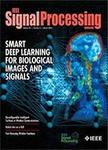版权所有:内蒙古大学图书馆 技术提供:维普资讯• 智图
内蒙古自治区呼和浩特市赛罕区大学西街235号 邮编: 010021

作者机构:Univ Florida Gainesville FL 32611 USA Uppsala Univ Dept Informat Technol Uppsala Sweden Univ Florida Dept Elect & Comp Engn Gainesville FL 32611 USA
出 版 物:《IEEE SIGNAL PROCESSING MAGAZINE》 (IEEE Signal Process Mag)
年 卷 期:2014年第31卷第3期
页 面:157-162页
核心收录:
主 题:Waveforms Scattering Signal processing algorithms Cost function Algorithm design and analysis Web sites Sensors
摘 要:In active sensing, transmitters emit probing waveforms into the environment. The probing waveforms interact with scatters that reflect distorted copies of the waveforms. Receivers then measure the distorted copies to infer information about the environment. The choice of the probing waveform is important because it affects slant range resolution, Doppler tolerance, clutter, and electronic countermeasures. A traditional performance metric for the probing waveform is the ambiguity function, which describes the correlation between the waveform and a delayed and (narrowband) Doppler shifted copy of the same waveform [1]. The direct synthesis of a waveform given a desired ambiguity function is exceedingly difficult [2]. Often designers focus on optimizing only the waveform?s autocorrelation function (which is the zero Doppler cut of the ambiguity function). Any method that optimizes the autocorrelation function is implicitly performing spectral shaping by trying to flatten the passband of the waveform?s spectrum [1], [2].